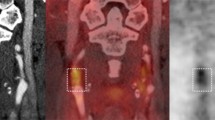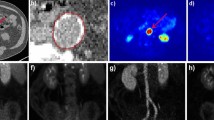Abstract
Vascular wall 18F-FDG uptake is often used as a surrogate marker of atherosclerotic plaque inflammation. A potential caveat is that vascular wall 18F-FDG uptake is higher simply because more atherosclerosis is present. To determine if the degree of inflammation is high or low relative to the extent of atherosclerosis, vascular wall 18F-FDG uptake may require statistical adjustment for a non-inflammatory marker reflecting the extent of atherosclerosis, e.g. calcification. Adjustments is probably needed if (1) vascular wall 18F-FDG uptake correlates sufficiently strongly with arterial calcification and (2) adjustment for extent of calcification affects determinants of vascular 18F-FDG uptake. This study addresses these questions. 18F-FDG PET/low-dose-CT scans of 99 patients were used. Cardiovascular risk factors were assessed and PET/CT scans were analysed for standardized 18F-FDG uptake values and calcification. ANOVA was used to establish the association between vascular 18F-FDG uptake and calcification. Multiple linear regression (with and without calcification as independent variable) was used to show whether determinants of vascular 18F-FDG uptake were affected by the degree of calcification. 18F-FDG uptake was related to increased calcification in the aortic arch, descending and abdominal aorta. However, 18F-FDG uptake showed considerable overlap between categories of calcification. Age and body mass index were main determinants of vascular 18F-FDG uptake. In multiple regression analyses, most standardized beta coefficients of these determinants were not affected by adjustment for the degree of calcification. Although vascular 18F-FDG uptake is related to total atherosclerotic burden, as reflected by vascular calcification, the association is weak and unlikely to affect the identification of determinants of atherosclerotic inflammation implicating no need for adjustment in future studies.



Similar content being viewed by others
Abbreviations
- ANOVA:
-
Analysis of variance
- ASCVD:
-
American society of cardiovascular disease
- BMI:
-
Body mass index
- CT:
-
Computed tomography
- FDG:
-
Fluorodeoxyglucose
- GCA:
-
Giant cell arteritis
- hsCRP:
-
High sensitivity c-reactive protein
- MRI:
-
Magnetic resonance imaging
- PET:
-
Positron emission tomography
- ROI:
-
Region of interest
- SUV:
-
Standardized uptake value
References
Benjamin EJ, Virani SS, Callaway CW et al (2018) Heart disease and stroke statistics-2018 update: a report from the American Heart Association. Circulation 137(12):e67–e492
Boyle JJ, Bowyer DE, Weissberg PL, Bennett MR (2001) Human blood-derived macrophages induce apoptosis in human plaque-derived vascular smooth muscle cells by Fas-ligand/Fas interactions. Arterioscler Thromb Vasc Biol 21(9):1402–1407
Falk E (1992) Why do plaques rupture? Circulation 86(6):III30–III42.
Jander S, Sitzer M, Schumann R et al (1998) Inflammation in high-grade carotid stenosis: a possible role for macrophages and T cells in plaque destabilization. Stroke 29(8):1625–1630
Hansson GK, Libby P, Tabas I (2015) Inflammation and plaque vulnerability. J Intern Med 278(5):483–493
Tawakol A, Migrino RQ, Bashian GG et al (2006) In vivo 18F-fluorodeoxyglucose positron emission tomography imaging provides a noninvasive measure of carotid plaque inflammation in patients. J Am Coll Cardiol 48(9):1818–1824
Davies JR, Rudd JH, Fryer TD et al (2005) Identification of culprit lesions after transient ischemic attack by combined 18F fluorodeoxyglucose positron-emission tomography and high-resolution magnetic resonance imaging. Stroke 36(12):2642–2647
Figueroa AL, Subramanian SS, Cury RC et al (2012) Distribution of inflammation within carotid atherosclerotic plaques with high-risk morphological features: a comparison between positron emission tomography activity, plaque morphology, and histopathology. Circ Cardiovasc Imaging 5(1):69–77
Silvera SS, Aidi HE, Rudd JH et al (2009) Multimodality imaging of atherosclerotic plaque activity and composition using FDG-PET/CT and MRI in carotid and femoral arteries. Atherosclerosis 207(1):139–143
Iwatsuka R, Matsue Y, Yonetsu T et al (2018) Arterial inflammation measured by (18)F-FDG-PET-CT to predict coronary events in older subjects. Atherosclerosis 268:49–54
Figueroa AL, Abdelbaky A, Truong QA et al (2013) Measurement of arterial activity on routine FDG PET/CT images improves prediction of risk of future CV events. JACC Cardiovasc Imaging 6(12):1250–1259
Bucerius J, Duivenvoorden R, Mani V et al (2011) Prevalence and risk factors of carotid vessel wall inflammation in coronary artery disease patients: FDG-PET and CT imaging study. JACC Cardiovasc Imaging 4(11):1195–1205
Eisen A, Tenenbaum A, Koren-Morag N et al (2008) Calcification of the thoracic aorta as detected by spiral computed tomography among stable angina pectoris patients: association with cardiovascular events and death. Circulation 118(13):1328–1334
Hoffmann U, Massaro JM, D'Agostino RB Sr, Kathiresan S, Fox CS, O'Donnell CJ (2016) Cardiovascular event prediction and risk reclassification by coronary, aortic, and valvular calcification in the Framingham Heart Study. J Am Heart Assoc 5(2):e003144
Ben-Haim S, Kupzov E, Tamir A, Israel O (2004) Evaluation of 18F-FDG uptake and arterial wall calcifications using 18F-FDG PET/CT. J Nucl Med 45(11):1816–1821
Blomberg BA, de Jong PA, Thomassen A et al (2017) Thoracic aorta calcification but not inflammation is associated with increased cardiovascular disease risk: results of the CAMONA study. Eur J Nucl Med Mol Imaging 44(2):249–258
Derlin T, Toth Z, Papp L et al (2011) Correlation of inflammation assessed by 18F-FDG PET, active mineral deposition assessed by 18F-fluoride PET, and vascular calcification in atherosclerotic plaque: a dual-tracer PET/CT study. J Nucl Med 52(7):1020–1027
Quirce R, Martinez-Rodriguez I, Banzo I et al (2016) New insight of functional molecular imaging into the atheroma biology: 18F-NaF and 18F-FDG in symptomatic and asymptomatic carotid plaques after recent CVA. Preliminary results. Clin Physiol Funct Imaging 36(6):499–503
Goff DC Jr, Lloyd-Jones DM, Bennett G et al (2014) 2013 ACC/AHA guideline on the assessment of cardiovascular risk: a report of the American College of Cardiology/American Heart Association Task Force on Practice Guidelines. J Am Coll Cardiol 63(25):2935–2959
Ridker PM, Danielson E, Fonseca FA et al (2009) Reduction in C-reactive protein and LDL cholesterol and cardiovascular event rates after initiation of rosuvastatin: a prospective study of the JUPITER trial. Lancet 373(9670):1175–1182
Lensen KDF, van Sijl AM, Voskuyl AE et al (2017) Variability in quantitative analysis of atherosclerotic plaque inflammation using 18F-FDG PET/CT. PLoS ONE 12(8):e0181847
Rominger A, Saam T, Wolpers S et al (2009) 18F-FDG PET/CT identifies patients at risk for future vascular events in an otherwise asymptomatic cohort with neoplastic disease. J Nucl Med 50(10):1611–1620
Author information
Authors and Affiliations
Corresponding author
Ethics declarations
Conflict of interest
The authors declare that they have no conflict of interest.
Additional information
Publisher's Note
Springer Nature remains neutral with regard to jurisdictional claims in published maps and institutional affiliations.
Electronic supplementary material
Below is the link to the electronic supplementary material.
Rights and permissions
About this article
Cite this article
Lensen, KJ.D.F., Voskuyl, A.E., Comans, E.F.I. et al. Should vascular wall 18F-FDG uptake be adjusted for the extent of atherosclerotic burden?. Int J Cardiovasc Imaging 36, 545–551 (2020). https://doi.org/10.1007/s10554-019-01744-0
Received:
Accepted:
Published:
Issue Date:
DOI: https://doi.org/10.1007/s10554-019-01744-0




